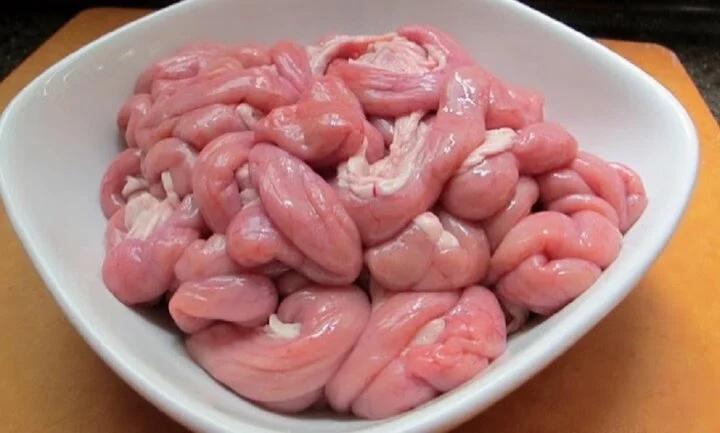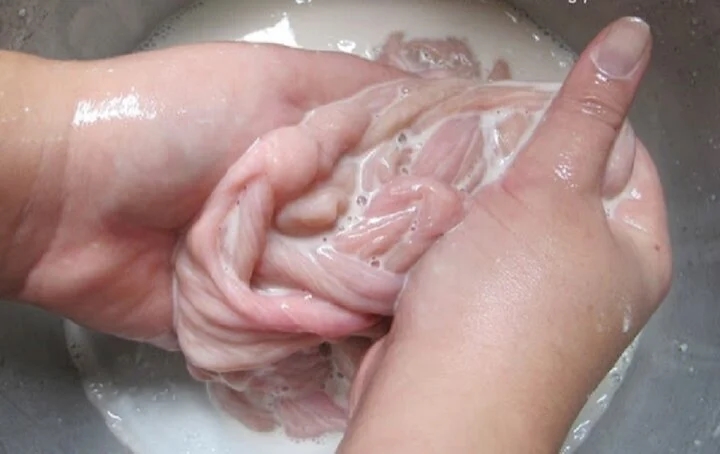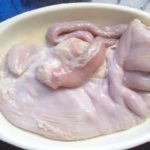How to Choose and Clean Tripe: A Step-by-Step Guide
Selecting and cleaning tripe properly is crucial to ensuring a delicious and safe meal. Here’s a comprehensive guide to help you master the process:
Choosing High-Quality Tripe
Opt for tripe strips that are medium-thick and soft. When lightly squeezed, they should release a white liquid. Avoid tripe with a yellowish liquid, as it’s older and may have a bitter taste after cooking.
Double tripe, with its two thin outer layers, is usually tender and more flavorful. However, it’s rare, so you may need to pre-order or visit the market early to find it.

Choose fresh tripe for the best results. (Image: Annieliciousfood)
Eliminating Odor from Tripe
After purchasing tripe, cleaning it effectively is key to a flavorful dish. Here are simple techniques to remove any unpleasant smell:
Soaking in Salt
Salt is an effective way to draw out and absorb odors while cleaning tripe. Fill a large bowl or sink with cold water and add a generous amount of salt. Submerge the tripe for 15-30 minutes, then rinse thoroughly with cold water. Gently squeeze the tripe to remove any remaining impurities.
Cleaning with Salt and Vinegar
Flip the tripe inside out and remove any mucus. Use a ginger stalk to push the slime out or gently scrape it off by hand. Then, use a mixture of salt and vinegar to clean it.
Rinse the tripe thoroughly with clean water to remove any residue.
Using Lemon and Salt
Similar to the previous method, after cleaning the inside of the tripe, squeeze it with lemon juice and salt. The lemon’s acidity helps neutralize odors, while the salt kills bacteria.
Rinse the tripe well and blanch it in boiling water to make it firm and crisp. Then, rub it again to ensure it’s thoroughly clean.

Using lemon and flour to remove odor from tripe (Image: Annieliciousfood)
Flour and Lemon Paste
Apart from the above methods, you can also use flour and lemon to eliminate odor from tripe. Turn the tripe inside out and clean its insides. Mix flour with coarse salt and squeeze it onto the tripe, then rinse with water.
After cleaning, rub the tripe vigorously with lemon juice and rinse again with clean water; gently massage the tripe to remove any remaining dirt.
Tips for Tripe Preparation
Over-cleaning tripe can make it tough and dry. To avoid this, follow these steps:
– Cut the tripe into smaller sections (around 12-14 inches) for easier handling.
– Squeezing the tripe with salt is crucial for removing odors.
– Rinse the tripe gently in clean water, avoiding excessive squeezing to preserve its texture.
Boiling Tripe for Crispiness
For crispy boiled tripe, boil water in a pot and add crushed lemongrass and ginger. Lemongrass and ginger infuse the tripe with a natural aroma and enhance its flavor.
Once the water boils, submerge the tripe in the pot and cook for about 2 minutes. Remove it and plunge it into a bowl of ice water. The ice water bath halts the cooking process, preserving the tripe’s crispness and natural white color. Add some lemon juice to enhance the flavor and further brighten the tripe.
Bring the water to a boil again, add the soaked tripe, and boil it on high heat for about 1 minute. Remove it and submerge it in ice water once more. The total boiling and chilling time of around 3 minutes is sufficient to cook the tripe while maintaining its crispiness and white color.
Source: VTC news


































